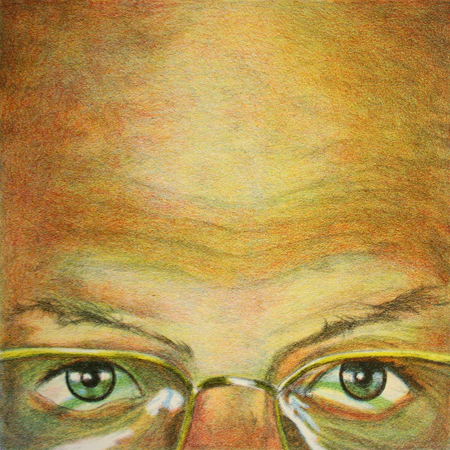Making a Stone Lithograph
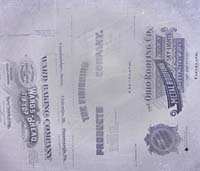
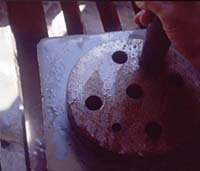
Many stones that were once used commercially have old images on one or both sides. If these images are particularly nice, like an old circus poster or beer advertisement, they may be refreshed and reprinted. (If they're boring, they may still be reprinted but no-one ever does.) Although stones are still being quarried in Germany, the majority of stones in American studios are recycled, and many still have images on the back.
Before a new image can be drawn, the old image must be grained off with a large metal disk, water and carborundum grit. Several grades of coarseness are used in succession. This takes anywhere from 30 minutes to several hours depending on the size of the stone, the stubbornness of the image and skill of the grainer. Great care must be taken to keep the stone remains perfectly flat so it doesn't break when printed due to uneven pressure.
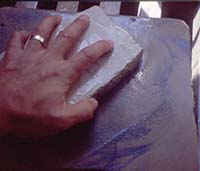
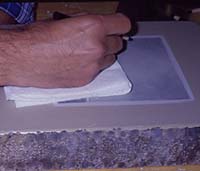
After graining, the stone is polished with very fine grit and a small piece of litho stone.
The edges of the stone are masked with gum arabic and drawing commences. Here the artist is drawing with a fine grease pencil and protecting the stone from any stray hand grease with a paper towel.
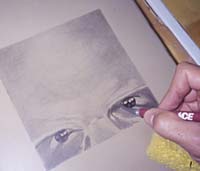
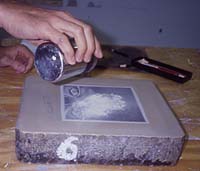
The drawing is made with special grease pencils called (not surprisingly) litho crayons. These crayons contain both grease and pigment. Once the grease touches the stone, the mark is made, so great care must be taken to keep the drawing clean. Small mistakes can be honed off the surface of the stone with abrasive sticks, although this damages the printing surface somewhat. The image drawn on this stone is being touched up carefully with a sharp knife.
Once the artist is certain the drawing is done, powdered rosin and talc are applied and the excess brushed off with a clean soft brush.
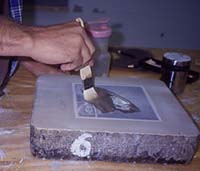
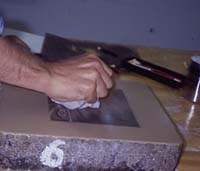
The etch is a mixture of gum arabic and nitric acid. It is painted over the surface of the stone and gently massaged into the grain of the drawing for several minutes. This process drives the grease into the surface of the stone. The adsorbed grease layer will attract the greasy ink in the printing process. The non-image areas of the stone are desensitized to grease and will stay wet during the printing process.
After etching, the gum layer is buffed down with a dry cheesecloth until the grease drawing starts to smear over the surface of the dry gum. The gum layer must be very thin so the grease pencil drawing can be washed off the stone with petroleum based solvents (mineral spirits and others). The gum is water based and doesn't dissolve in the solvent.
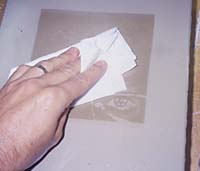
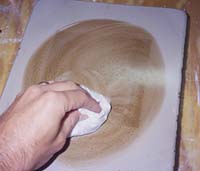
Here, solvent is being used to dissolve the original drawing. It looks like the entire image is being destroyed, but this is not a problem. Although the drawing has been erased, the grease from the drawing has penetrated into the stone, and will attract the greasy ink during the printing process.
To reinforce this grease reservoir, a thin layer of super-greasy asphaltum is rubbed over the gum stencil.
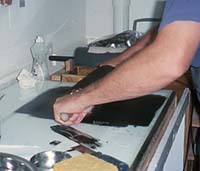
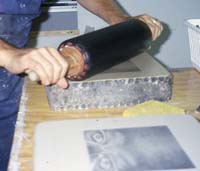
Ink is then rolled out with a leather roller. These rollers are hand-made, and if properly cared for will outlast all but the heartiest and longest-lived lithographers. The ink is made of burned linseed oil and finely ground pigment. It is very sticky and very greasy.
Although this stone will be printed in red, it is rolled up in black in first, then etched a second time in order to stabilize the image on the stone. This image shows two stones. The stone in the foreground will be used to print a different color. Although the stones can be printed in any color, they are always drawn and initially rolled up in black.
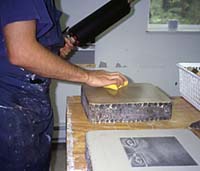
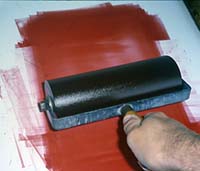
Next, the gum is washed off the stone with water, and the inky leather roller is rolled back and forth over the image, from every different direction. This is repeated anywhere from 10-50 times until the image is fully inked. This process is called the "roll up". After the roll up, the stone is etched a second time before printing.
Once the printer has prepared the printing paper and gathered all the supplies, the printing ink is rolled out on a glass slab. If the image is to be printed in color a rubber roller is used. Although the leather rollers are superior for rolling ink, they cannot be cleaned thoroughly enough for color printing and are reserved for black ink only. As stated above, no matter what color the image is to be printed in, it is drawn with black crayons and rolled up with black ink first.
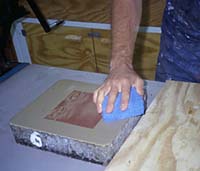
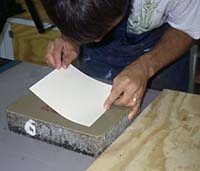
The black ink is washed out with solvents, the stone is placed on the press, the gum is washed off with water, and the image is rolled up in printing ink. This image shows the stone to be printed in red on the press bed, ready to print.
The paper is lined up to tiny marks scratched into the surface of the stone. If the print will only have one color run, accuracy is not critical. For multi-color prints, careful paper placement is essential. A cover sheet (clean newsprint or scrap paper) covers the printing paper to protect it and cushion it slightly.
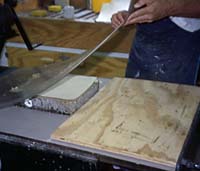
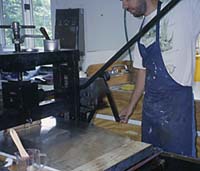
The tympan is a tough sheet of leather, press board or lexan. This is placed on top of the stone, so the wood and leather scraper bar can slide over its greased surface. Great care is taken to keep the tympan grease only on the top of the tympan, and not on the bottom side that rests on the stone and the print paper. The grease will stain the paper, and will attract unwanted ink on the stone.
Next, the pressure bar is pulled down, applying great downward force to tympan, cover sheet, print paper and stone.

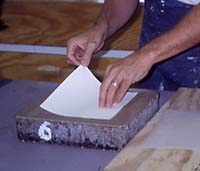
The press bed is cranked through, with the scraper bar sliding over the top of the tympan, and apply pressure to the back of the paper to drive the printing ink into the paper's fiber. Because the ink layer is so thin, it requires great pressure to transfer completely.
The pressure bar is released, the press bed is cranked back to starting position, the tympan is raised, the cover sheet is removed, and the print paper is lifted off the stone.
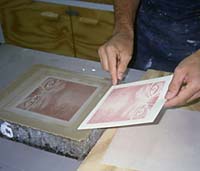
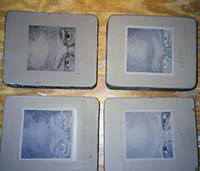
The printed image is carefully compared to the image on the stone to determine if the pressure and ink are correct. Adjustments are made and the printing process is repeated until one good print is pulled. This print is set to the side, and all subsequent prints are compared to this print to insure consistency in the edition.
For multiple color prints, a different stone is prepared for each color printed. Alternatively, a stone may be printed, then grained, and the next color drawn on the same stone. Also, many contemporary lithographers use aluminum plates, which are more portable and don't require graining (they are only used once). Pictured here are the stones prepared for the print The Eyes and Forehead of My Dear Friend, Mr. Donald Roberts. From the top left clockwise they are the drawings for the black, yellow, blue and red inks. The finished print is pictured below.
